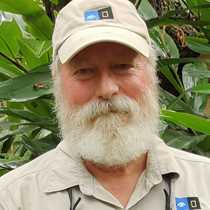Tierra del Fuego
By mid-morning, we had reached the “End of the World,” which seemed a bit odd to us, having just returned from a place so much farther beyond it. Cape Horn is, however, the southernmost reach of South America. The Horn is actually a headland on an island called Isla Hornos and is part of the Tierra del Fuego Archipelago (see image, above left). Sir Francis Drake is credited with having been the first to sail in these waters, and it was he who realized Tierra del Fuego was an island and not part of the long-sought Terra Australis Incognita. However, it was a Dutchman named Willem Schouten who first rounded the Horn, in 1616, while searching for a trade route to the Orient. He named it Hoorn, after his birthplace in Holland.
Cape Horn lies within the infamous west wind drift region known as the Furious Fifties, and is frequently buffeted by severe storms. Windy conditions this morning helped us get a real feel for the significance associated with ‘Rounding the Horn’ long ago in the days of big sailing ships. There are numerous historical accounts of ships sailing from the Atlantic to the Pacific around the Horn (against the wind) and taking weeks or even months to accomplish it…if at all. Countless seamen have been lost in these waters over the centuries and there is now an impressive monument erected here to their memory. It consists of a huge sculpture made up of several irregularly-shaped vertical plates of stainless steel, which are set in such a way that when a passing ship views them from seaside, they present a view of a wandering albatross. This is very appropriate, because sailors of old believed the souls of drowned sailors were carried by albatrosses, as described in this beautiful poem by Sara Vial…
I am the albatross that awaits you at the end of the world.
I am the forgotten soul of the dead mariners
who rounded Cape Horn from all the seas of the world.
But they did not perish in the furious waves,
today they fly on my wings for all eternity
in the ultimate embrace of the Antarctic winds.
For the rest of the day we were within sight of land off the port side and by late afternoon, we had reached the eastern entrance to the Beagle Channel. This waterway, named for the famous vessel that carried Charles Darwin on his world-wide voyage in the 1830s, separates the Chilean islands to the south from the Argentine portion of Tierra del Fuego to the north. Once inside the channel, our Argentine pilots came aboard and we made our way to Ushuaia, the southern-most city in the world…where we began our expedition 10 days ago.
We were very comforted to see forests again and it was quite interesting to view the low tree line on the mountains along the northern shore of the channel (see image, above right)…a consequence of the high latitude (about 55° S). We were berthed by the time dinner was finished and conditions were ideal for a pleasant stroll ashore this evening. Quite a few of us managed to experience a bit of the local nightlife.




